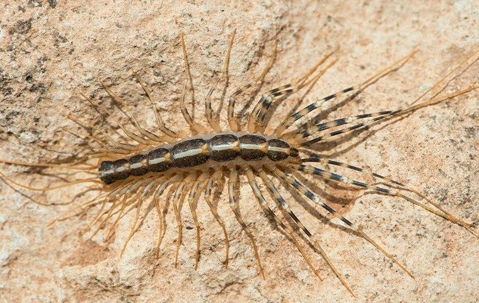In the insect world, bugs that seem harmless to us can be some of the most fearsome hunters for much smaller creatures. To us, for example, a centipede is a docile insect, but to a house spider or an ant, centipedes are massive predators that they must hide from. Often, they hide indoors, inside of homes and businesses, since centipedes can’t invade properties as easily. But this is exactly why centipedes can be signs of larger pest problems, and the presence of them out in your yard can indicate bigger problems.
What Are Centipedes?
Centipedes are worm-like insects with long bodies and many legs. They have hard, shelled exoskeletons and tend to grow several inches long, making them the hulking tanks of the insect battlegrounds. Even spiders, which hunt smaller bugs with impunity, are no match for venomous centipedes that are several times their size. While all centipedes have paralyzing venom that they use to incapacitate their prey, this isn’t strong enough to harm people or pets. Centipedes can certainly look a lot more dangerous than they are to us, with their barbed bodies and often large size, so having them around isn’t exactly pleasant even if they aren’t considered dangerous pests. However, as other pests flee from gardens and yards to get away from hunting centipedes, the likelihood that they will be driven indoors increases. Once pests have the safety of your walls and voids to rely on, their populations can grow out of control.
Where Centipedes Are Found
Centipedes are typically outdoor pests. They tend to hunt around for garden insects, particularly soft-bodied insects that eat foliage or vegetation. As such, centipedes can be helpful for green thumbs who want to keep garden pests at bay. However, foraging insects will take advantage of other access points to flee from predators, meaning a centipede population can quickly lead to other pest problems. While centipedes are often too big to utilize the tiny cracks and holes that other bugs can use to gain access to your interior, they can make it inside in other ways. Poorly maintained homes can have hidden access points that all sorts of pests can use to enter through walls. That’s why general pest prevention is necessary to combat centipedes and the migrations that they cause.
Centipede Prevention For Your Property
To avoid centipedes and the larger issues that bring, it’s important to reduce the factors that attract all kinds of pests to your property, as well as the maintenance issues that often lead to infestations. Here are some ways to accomplish this:
Landscaping: Keeping a well-maintained lawn will reduce harborage points for insects of all kinds to use as nesting grounds. Keeping gardens and flower beds away from your exterior is also crucial.
Moisture Control: All sorts of pests will be attracted to areas of moisture buildup, including centipedes. Ensure proper drainage outside and address any water damage that makes your exterior walls more accessible to pests.
Treatments: The surest form of pest protection is through exterior treatments of your lawn and structures. Safe and effective chemical sprays can prevent a wide range of pests.
Let Experts Help With Control
As you’ve probably realized by now, one pest problem often begets another. This chain reaction on your property can be prevented entirely through the diligent efforts of property owners and partnerships with local pest experts. At Quik-Kill Pest Eliminators, our trained staff can help you with pest prevention and control, whether it’s centipedes that are the concern or some other pest that might attract them to your property. We can get started right away on an inspection, checking for existing problems or areas where infestations could easily start. From there, we’ll work with you to form a pest control plan that’s tailored to your property and your budget.
For true protection from garden pests that can easily invade indoors, trust Quik-Kill Pest Eliminators.

